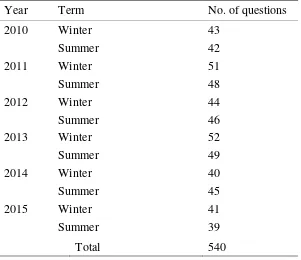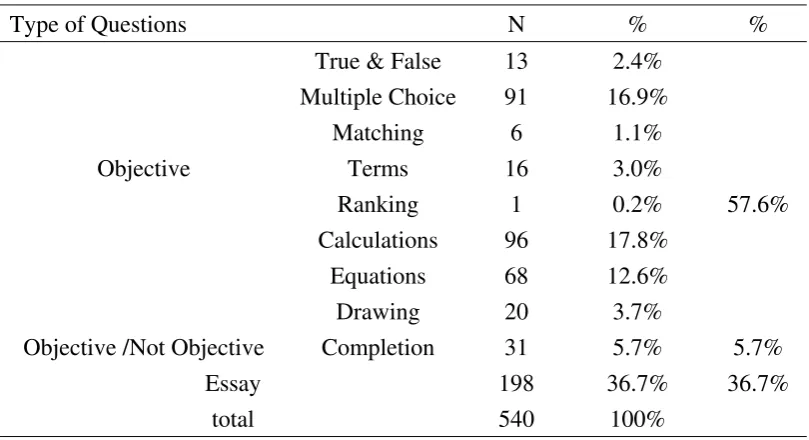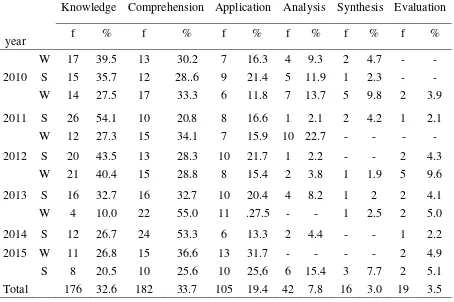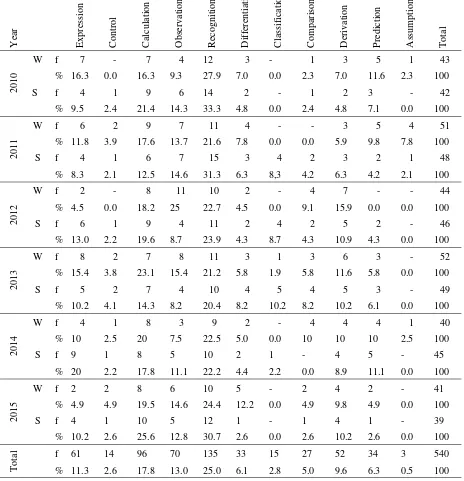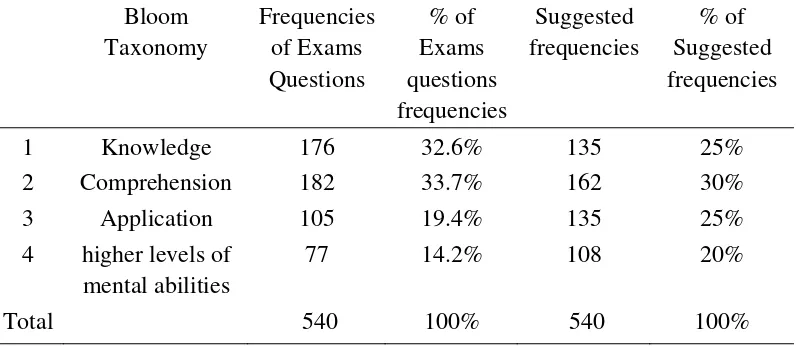Evaluation of Chemistry Questions in the General
Secondary Examination in Jordan for Years 2010 –
2015
Zuhair M. Allouh1,*
1
Department of Vocational Education, Al-Huson College, AL-Balqa Applied University,
Irbid, Jordan
*Correspondence: Department of Vocational Education, Al-Huson College, AL-Balqa Applied University, P. O. Box: 50, Al-Huson, Irbid, Jordan. Tel: 962-795-643-180. E-mail: zallouh@gmail.com
Received: August 31, 2016 Accepted: September 14, 2016 Published: October 12, 2016
doi:10.5296/ije.v8i4.9927 URL: http://dx.doi.org/10.5296/ije.v8i4.9927
Abstract
This study aimed to evaluate chemistry questions from the General Secondary Examination in Jordan (Altawjihi) for the years 2010 – 2015. Criteria for evaluation included type of questions (objective vs. essay), inclusion of Bloom's Taxonomy of Cognitive Domain, and the availability of chemistry processes. This study was accomplished by following the style of content analysis that considers the sub-question as the unit of analysis and then determines which standards are included in the questions. The number of questions that were analyzed reached to 540 sub-questions. The researcher used frequencies, percentages, chi-square distribution, and Holsti's method in the statistical treatment to calculate the stability of the question analysis. The results exhibited the domination of objective questions over essay questions and questions of completion. Objective questions dominated the findings (57.6%). Essay questions were second most frequently used (36.7%), with completion questions used least frequently (5.7%). Questions that measure lower cognitive levels also outperformed the other types, reaching 85.7%. However, the questions that measure higher cognitive levels (as based on Bloom’s Taxonomy of the Cognitive Domain— analysis, synthesis, and evaluation) were only sparingly used, at 7.8%, 3.0%, and 3.5%, respectively. Chemical calculation and recognition occupied center stage in the educational processes for achieving chemical knowledge and chemical expression, whereas the assumption process has been used almost not at all (0.5%).
1. Introduction
Examinations have become an important factor directing the work of both teacher and student. Therefore, exams and other methods of evaluation have gained a great importance in the field of education. Educators must pay much attention to the preparation of exam questions and their conformity with the standards and objectives of the teaching process. If the exam questions are not properly designed to reflect the teaching objectives, then they will not be useful in measuring the students’ learning outcomes.
Currently, methods of examination and evaluation have achieved great progress over the past. The process of evaluation has become an integral part of the educational process; it also has developed a diagnostic and remedial function that helps to continually correct and enhance the process of education. Moreover, evaluation is currently characterized by being inclusive, objective, and diverse so that it will assist in the discovery of talents, abilities, achievements, and capabilities. In addition, evaluation helps educators and administrators determine the extent to which school educational objectives have been achieved (Sarhan, 1985). Examinations are essential components of the educational curricula. Therefore, their analysis and revision will highlight the strengths and weaknesses of these curricula, which in turn permits further enhancement of the educational process.
Examinations take important roles in the teaching process as they direct the academic orientations of the students and improve their learning capabilities. Therefore, exams must be constantly modified and corrected to comply with the educational process and its objectives (Eisawy, 1985). The Ministry of Education in Jordan has given considerable attention to the examinations via continuous development of their mechanisms and procedures in keeping with the Educational Reform for a Knowledge-Based Economy (ERfKE) directives. Based on this, a new evaluation scheme for schools was developed which included new strategies and tools that were founded based on authentic (real) concepts of evaluation, including standards and indicators designed according to learning outcomes (Ministry of Education, 2012).
The General Secondary Examination (GSE, Altawjihi) is one of the most important tests that the students in Jordan face in their secondary levels of education. This has developed because of the significant role this test plays in determining the upcoming student’s scientific specialization at the university. Thus, GSE has a strong impact when reviewing the curricula of the final two years at high school. Furthermore, this exam has a great influence on the activities of the students and their daily concerns (Al-Bahadly, 2009).
showed the domination of objective questions over essay questions. In terms of cognitive levels, the application questions came in first place, followed by knowledge questions and finally comprehension questions. Concerning chemical processes, the chemical calculations came at the top of the list, followed by chemical expression, recognition, assumption, control, differentiation, comparison, and finally prediction. In another study, the chemistry questions for the general secondary certificate were analyzed for the years of 1998, 1999, and 2000 (Al-Banna, 2001). The study showed that the questions that actually measured the level of knowledge during those three years were 89%, 78%, and 83%, respectively. However, the percentages of questions that measured the higher cognitive levels were 2%, 0.9%, and only 0.8%, respectively. In addition, the percentages of the questions that measured the drawing skills were very low. Al-Rashed (2001) aimed to analyze the questions provided by chemistry textbooks at the secondary level in Saudi Arabia. The results of his analysis showed that knowledge, comprehension, and application levels received the highest degrees of representation, with the proportion of objective questions being 84%, and essay questions being 16%. Moreover, a different study found that 96% of chemistry questions did not exceed the minimum cognitive skill levels in several different schools in Turkey (Karamustafaoǧlu, Sevim, Karamustafaoǧlu,& Cepni, 2003).
Based on these facts, this study aims to evaluate the chemistry questions in the GSE (Altawjihi) in Jordan from 2010 to 2015 according to the types of questions (objective vs. essay), their distribution within Bloom's levels of cognitive domain, and their measurement of chemical processes. This study tests the hypothesis that “the distribution of chemistry questions in the General Secondary Examination (Altawjihi) in Jordan is not consistent with the experts’ proposed allocations to Bloom's taxonomy levels in the cognitive domain.” The findings of this study could assist in future planning for chemistry questions on the governmental exam and also could help chemistry teachers acquire better knowledge of quality question standards and apply them to developing their own school tests.
2. Methodology and Procedures
2.1 Population and Subjects
Table 1. The Number of Sub-Questions in All Sessions (Winter and Summer Terms) of the General Secondary Examination in Jordan for Years 2010-2015
Year Term No. of questions
2010 Winter 43
Summer 42
2011 Winter 51
Summer 48
2012 Winter 44
Summer 46
2013 Winter 52
Summer 49
2014 Winter 40
Summer 45
2015 Winter 41
Summer 39
Total 540
2.2 Research Tool
The necessary data for the research has been collected utilizing the analysis tools that were used by Jassim (2000) to analyze the dimensions of the type of questions (objective or essay), Bloom's taxonomy of cognitive domain, and the processes of chemistry. To ensure the stability of the analysis process, the researcher conducted the analysis twice at two different time periods to show the percentage of agreement between the results of the first analysis process and the second. The researcher analyzed the questions for the first time and then revised the analysis process again after two months from the first analysis. Reliability coefficient was calculated between the two analyses using Holsti's equation. The results showed the existence of high stability of parameters for the analysis process, as the value of reliability coefficient was (0.865).
2.3 Statistical Analysis
To evaluate the chemistry exam questions, the researcher used the following:
1. Frequencies and percentages, and 2. Chi-square test for the distribution differences between the number of question frequencies in the exams and the question frequencies suggested by the experts for the Bloom's Taxonomy of Cognitive Domain.
2.4 Study Limitations
3. Results and Discussion
The question types (objective or essay) included in the high school exams for chemistry in Jordan for the years 2010 to 2015 were counted. The frequencies and percentages for each type of sub-question are shown in Table 2.
Table 2. Frequencies and Percentages for Different Types of Questions Included in Chemistry Exams in Jordan from the Year 2010 to 2015
Type of Questions N % %
True & False 13 2.4%
Multiple Choice 91 16.9%
Matching 6 1.1%
Objective Terms 16 3.0%
Ranking 1 0.2% 57.6%
Calculations 96 17.8%
Equations 68 12.6%
Drawing 20 3.7%
Objective /Not Objective Completion 31 5.7% 5.7%
Essay 198 36.7% 36.7%
total 540 100%
It is evident from Table 2 that objective questions were the most common and constituted 57.6% of total questions. The essay questions were less common than the objective ones and constituted 36.7%. On the other hand, the completion questions were the least common as they constituted only 5.7% of the exam questions. The predominance of objective questions can be attributed to the high percentages of calculation, multiple choice, and equational questions. Specifically, calculation questions had the highest percentage (17.8%), followed by multiple choice questions (16.9%), and then questions related to solving equations (12.6%). However, the ranking questions were the least common (0.2%).
These results are consistent with the findings of Jassim's study (2000) that also showed the predominance of objective questions versus essay questions in chemistry textbooks in Kuwait. On the other hand, these results differ from the findings of Zaytoon's study (1990) which reported that questions from the science book at the third preliminary grade in Jordan mainly focuses on essay questions (87.7%), while objective questions form only 12.3% of the queries.
Table 3. Frequencies and Percentages of Bloom's Taxonomy of Cognitive Domain Contained in Chemistry Questions for the General Secondary Examination in Jordan for Years 2010-2015
year
Knowledge Comprehension Application Analysis Synthesis Evaluation
f % f % f % f % f % f %
W 17 39.5 13 30.2 7 16.3 4 9.3 2 4.7 - -
2010 S 15 35.7 12 28..6 9 21.4 5 11.9 1 2.3 - -
W 14 27.5 17 33.3 6 11.8 7 13.7 5 9.8 2 3.9
2011 S 26 54.1 10 20.8 8 16.6 1 2.1 2 4.2 1 2.1
W 12 27.3 15 34.1 7 15.9 10 22.7 - - - -
2012 S 20 43.5 13 28.3 10 21.7 1 2.2 - - 2 4.3
W 21 40.4 15 28.8 8 15.4 2 3.8 1 1.9 5 9.6
2013 S 16 32.7 16 32.7 10 20.4 4 8.2 1 2 2 4.1
W 4 10.0 22 55.0 11 .27.5 - - 1 2.5 2 5.0
2014 S 12 26.7 24 53.3 6 13.3 2 4.4 - - 1 2.2
2015 W 11 26.8 15 36.6 13 31.7 - - - - 2 4.9
S 8 20.5 10 25.6 10 25,6 6 15.4 3 7.7 2 5.1
Total 176 32.6 182 33.7 105 19.4 42 7.8 16 3.0 19 3.5
It is seen from table 3 that the lower levels of the Bloom’s Taxonomy of Cognitive Domain (knowledge, comprehension and application) have occupied the highest percentages of chemistry questions, reaching a total of 85.7%. However, the questions that measure the higher levels of knowledge and ability to make use of knowledge (analysis, synthesis, and evaluation) had lower percentages of 7.8%, 3.0%, and 3.5%, respectively. This indicates the need to increase the number of higher level questions within the chemistry field of GSE in Jordan.
In addition, the percentage of knowledge questions has varied from 54.1% in summer session of 2011 to 10.0% in winter session of 2014. The comprehension questions have varied, as well, from 55.0% in winter session of 2014 to 20.8% in summer session of 2011. The percentage of application questions also varied from 31.7% in winter session of 2015 to 13.3% in summer session of 2014. Analysis level questions varied from 22.7% in winter session of 2012 to 0% in both winter sessions of 2014 and 2015. Furthermore, it is noteworthy that the questions in the synthesis and evaluation levels never exceeded the level of 10%.
Taxonomy of Cognitive Domain, as would be desireable. These findings are consistent with the findings of several previous studies (Al-Rashed, 2001; Swart, 2010; Zaytoon, 1990).
Regarding chemistry processes, the frequencies and percentages for each process were calculated as shown in Table 4.
Table 4. Frequencies and Percentages of Chemistry Processes Included in Chemistry Questions for the General Secondary Examination in Jordan for Years 2010-2015
The results show that the most common chemistry process which the questions considered was recognition (25%). This refers to the focus on the questions that measure the ability to identify different types of chemical changes. The chemical calculation was the second most common process with a percentage of 17.8%. This process requires the ability to perform calculations for certain chemical reactions that include determining the concentrations of chemical substances or the volumes or concentrations of the resulting compounds. In addition, the percentage of observational questions was 13%. The process of observation is relevant to connecting similar things together after careful consideration, and discovering what they have in common. The expression process reached to a total percentage of 11.3%. This is a process that requires the ability to express certain chemical reactions with symbols such as the completion of chemical equations, or to illustrate the expression by drawing the shapes of molecules of certain chemical compounds. The questions on derivation, prediction, differentiation, comparison, classification, control, and assumption processes had low percentages, with the assumption process having the lowest percentage of 0.5%. These results disagree with the findings of Jassim (2000) that the chemical calculation process was the most common process, followed by the processes of chemical expression, recognition, assumption, control, differentiation, comparison, and finally prediction.
Lastly, the distribution of chemistry questions in the GSE in Jordan for the years 2010-2015 was compared with the experts’ proposed distribution according to Bloom's Taxonomy of Cognitive Domain (table 5). The percentages of chemistry questions in both comprehension and knowledge levels were higher than the proposed percentages. On the other hand, the percentages of questions in the application level and addressing higher levels of mental abilities were lower than the suggested percentages (table 5).
Chi-square analysis revealed a statistically significant difference (P<0.05) between the frequency of questions according to different levels of Bloom's Taxonomy of Cognitive Domain and the experts’ proposed frequencies. This can be attributed to high frequencies in the knowledge and comprehension levels, and low frequencies in the application and higher mental skills levels (table 6).
Table 6. Chi-Square Distribution Test Results for Frequencies of Bloom's Taxonomy of Cognitive Domain Contained in the Chemistry Questions for the General Secondary Examination in Jordan for Years 2010-2015, and the Suggested Frequencies of Bloom's Taxonomy of Cognitive Domain
Knowledge Comprehension Application higher levels of
mental abilities
Total
Frequencies of Chemistry Exam
Questions
176 182 105 77 540
Suggested Frequencies
135 162 135 108 540
Total 311 344 240 185
4. Conclusions
In conclusion, we found that more than half of the chemistry questions in the GSE in Jordan between 2010 and 2015 were of the objective type that includes mostly calculation and multiple choice questions. In addition, the questions focused mainly on recognition, calculation, and observational processes, while the processes of control and assumption were almost ignored. More importantly, most of the chemistry questions had concentrated on the lower levels of the Bloom’s Taxonomy of the Cognitive Domain and they were not consistent with the experts’ proposed guidelines for Bloom's Taxonomy levels.
5. Recommendations
Based on the findings of this study, the researcher recommends the following:
1. Inclusion of more chemistry questions in the GSE that relate to the higher mental levels identified by Bloom’s Taxonomy of the Cognitive Domain (analysis, structuring, and evaluation).
2. Inclusion of more chemistry questions related to prediction, comparison, classification, control, and assumption processes within the GSE in Jordan.
4. Designing a study to analyze questions contained in the chemistry textbooks for high school courses in Jordan, and to compare these textbook questions with questions presented to the students in the GSE chemistry exams.
Acknowledgement
This research was supported by a sabbatical leave grant from AL-Balqa Applied University in Jordan provided to Zuhair M. Allouh for the academic year 2015/2016.
References
Al-Bahadly, M. (2009). [Evaluation the Ministerial Chemistry Questions in the Six Scientific Class in Light of Mental Capacity of Guilford]. Derasat Tarbauieh, 6, 95-146. [In Arabic]
Al-Banna, H. (2001). [Analytical study of the Cognitive Levels in the Chemistry Exams for General Secondary Certificate]. Majalat Al-Tarbieh Al-Elmiah, 4(1), 9-35. [In Arabic]
Al-Rashed, I. (2001). [Analysis of the Questions Contained in the Books of Chemistry for the Three Grades of High School in Saudi Arabia]. Journal of the College of Education, University of Tanta, 21, 855-887. [In Arabic]
Eisawy, A. (1985). [Measurement and experimentation in psychology and education].
Alexandria, Egypt: Dar Al-Ma'rifah University. [In Arabic]
Jassim, S. (2000). [Evaluation of the Questions Contained in the Student's Book of Chemistry in the Scientific Fourth Secondary Grade in Kuwait in The Light of the Objectives of Teaching Chemistry in That Grade]. Educational Journal Kuwait, 14(54), 29-86. [In Arabic]
Karamustafaoǧlu, S., Sevim, S., Karamustafaoǧlu, O., & Cepni S. (2003). Analysis of Turkish High-School Chemistry-Examination Questions According to Bloom’s
Taxonomy. Chemistry Education: Research and Practice, 4(1), 25-30.
http://dx.doi.org/10.1039/B2RP90034C
Ministry of Education (2012). [Working paper: Development of general secondary
examination certificate]. Retrieved from: www.moe.gov.jo/Files/(22-4-2012)(8-46-07%20AM).doc [In Arabic]
Sarhan, E. (1985). Al-Manahej Al-Mu’aserah (5th ed.). Kuwait: Alfalah Library.
Swart, A. (2010). Evaluation of Final Examination Papers in Engineering: A Case Study
Using Bloom's Taxonomy. IEEE Transactions on Education, 53(2), 257-264.
http://dx.doi.org/10.1109/TE.2009.2014221
Public Schools in Jordan]. The Arab Journal of Educational Research, 10, 73-98. [In Arabic]
Copyright Disclaimer
Copyright for this article is retained by the author(s), with first publication rights granted to the journal.
